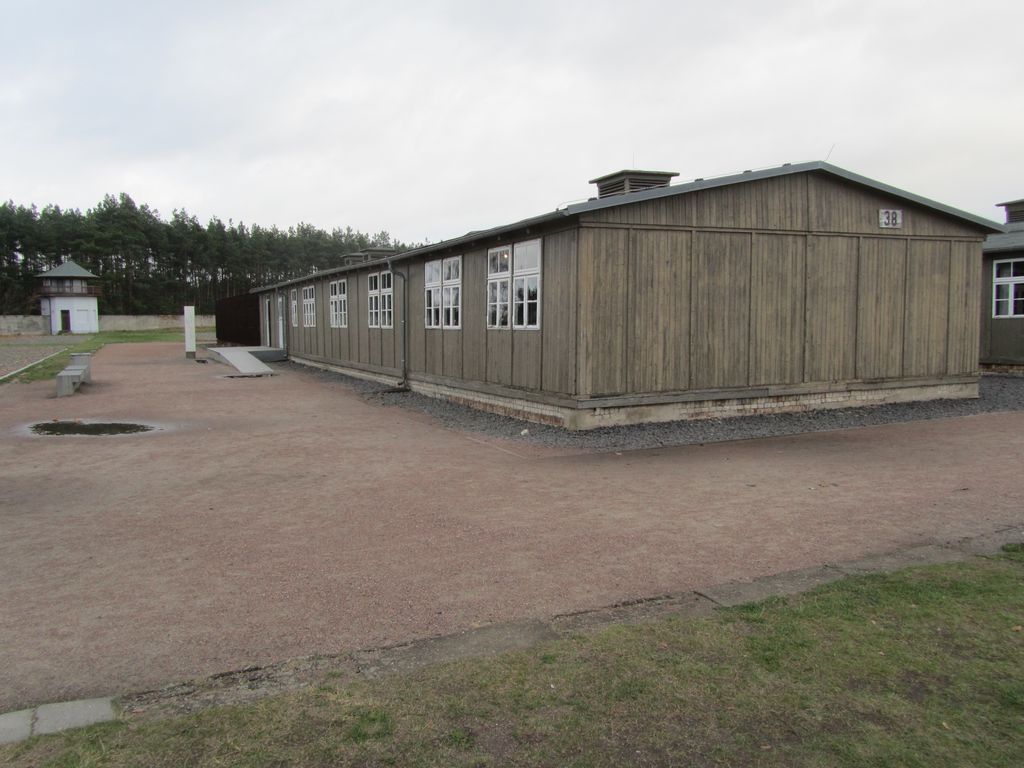Jewish Inmates in Sachsenhausen Concentration Camp 1936-1945
Barrack 38
Barrack 38 was built in summer 1938. It belonged to the zone known as the Small Camp. Among the first groups of people imprisoned there were Sinti and Roma. For a while after the “Kristallnacht” in November 1938, the Small Camp was almost completely occupied by over 6,000 Jewish internees. Up to 400 people were crammed into barracks that had been planned for 150. Barrack 38 and the adjacent numbers 37 and 39 came to be known in the camp as the “Jewish barracks”, because until 1942 they mostly accommodated Jewish prisoners. In October 1942, Heinrich Himmler ordered all of the concentration camps to begin deporting their Jewish prisoners to Auschwitz.
After that, the SS mainly used barrack 38 to accommodate prisoners from Poland and the occupied parts of Western Europe, including, in spring 1945, a group of women. The barracks were also used as temporary accommodation for female internees during the period of the Soviet Special Camp (1945–1950). In 1961, Barrack 38, which had been reconstructed from original material, was integrated into Sachsenhausen National Memorial as the Museum of the Resistance Struggle and the Suffering of Jewish Citizens.
The Museum
In 1992, shortly after a visit by the Prime Minister of Israel, Yitzhak Rabin, an arson attack destroyed the B-wing of the barrack and considerably damaged the other wing, as well as Barrack 39. This was one of a series of attacks carried out within Germany from 1992 onwards from far right-wing, anti-Semitic and xenophobic motives. Five years afterwards, in 1997, the repair and rebuilding work was completed. Designed by the architects Braun, Vogt & Partner from Frankfurt, the Barrack 38 Museum takes its external appearance from the no-frills architecture of the barrack’s now destroyed wing. A museum has been installed in the existing interior and in additional space provided by the insertion of a basement. Preserved behind glass panels, the traces left by the arson attack have been integrated into the exhibition, while they also mark the transition to the surviving original part of the building, which has been restored.
The Exhibition
The exhibition, titled “Jewish Prisoners in Sachsenhausen Concentration Camp 1936–1945”, is arranged chronologically in four sections. It examines the fate of Jews in the concentration camp closest to the German capital, with a special focus on the life stories of 74 of them. The exhibition, designed by architect Prof. HG Merz from Stuttgart, reflects the building’s two levels in its layout. As visitors go down into the basement, they are confronted with the time at the start of the war when the National Socialists intensified their persecution of the Jews.
The exhibition on the ground floor begins by telling the stories of individual Jewish prisoners who were incarcerated between 1936 and 1938 on political or social pretexts, or under the discriminatory Nuremberg “Race Laws”. With the pogrom of November 1938 came the first mass arrests made exclusively on racial grounds. In wartime, from 1939 to 1942, the Jews in Sachsenhausen were subjected to ever harsher conditions of imprisonment and increasingly organized maltreatment. The SS camp authorities repeatedly perpetrated acts of mass murder involving Jewish prisoners. Between 1942 and 1945, while the National Socialists were carrying out the genocide of European Jews in occupied eastern Europe, the Jews imprisoned in Sachsenhausen Concentration Camp were used as slave labour in so-called specialist squads such as the “forgers’ workshop”.
As the tide of war began to turn and the defeat of the Third Reich became ever more likely, the direction of the earlier deportations was reversed. From mid-1944 onwards, thousands of Polish, Hungarian, Czech and Slovakian Jews were taken from wherever they were living (even from the death camps) and put in Sachsenhausen Concentration Camp. The majority of them were sent to its satellite camps. The SS continued to murder Jews right up until the end of the war: even in April and May 1945 thousands lost their lives in the satellite camps, on the death marches and in the extermination units of the Industrial Yard at Sachsenhausen.

